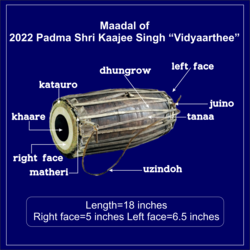 Nomenclature of Maadal | |
| Percussion instrument | |
|---|---|
| Other names | Mardala, Maadal, Mardal, Madal, Mirdang, Phakawaj, In Pali it is called Maddala. |
| Classification | Membranophone |
| Hornbostel–Sachs classification | 211.252.12 (membranophone--individual double-skin conical drum, both heads played) |
| Inventor(s) | Lord Biswarkarma or Kami (caste) |
| Developed | During Sixth Century |
| Related instruments | |
| Mridangam | |
| Musicians | |
| |
The madal (Nepali: मादल) or maadal is a Nepalese folk musical instrument.[1] The madal is used mainly for rhythm-keeping in Nepalese folk music. It is very popular and widely used as a hand drum in Nepal. The madal has a cylindrical body with a slight bulge at its center and heads at both ends, one head larger than the other. It is usually played horizontally in a seated position, with both heads played simultaneously.
The madal[2] is the national instrument of Nepal and is the backbone of most Nepali folk music.[3] The well-known Nepali musician Ranjit Gazmer introduced this instrument to Bollywood music when he started working under Rahul Dev Burman, and has used it in numerous Bollywood songs such as Hum Dono Do Premi and Kanchi Re Kanchi Re.[4] There is also a madal drum used by certain Adivasi groups.
- ^ "mādal · Grinnell College Musical Instrument Collection · Grinnell College Libraries". omeka-s.grinnell.edu. Retrieved 2023-12-06.
- ^ Poudel, Parsuram Prasad (2021-12-31). "The Historical Context and Present Scenario of Madal". Journal of Fine Arts Campus. 3 (2): 23–32. doi:10.3126/jfac.v3i2.48332. ISSN 2795-1782.
- ^ "Madal Folk Instrument of Nepal". ECS NEPAL. Retrieved 2023-12-06.
- ^ Gaekwad, Manish (2018-03-17). "R.D. Burman's percussionist Ranjit Gazmer is a symbol of the old days of Bollywood composition". The Hindu. ISSN 0971-751X. Retrieved 2023-12-06.